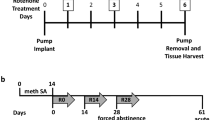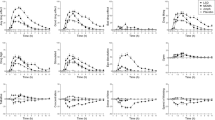A mitochondrial protein may mediate a dangerous side-effect of some recreational drugs.
Abstract
The recreational use of amphetamine-type stimulants can produce a marked and sometimes lethal increase in body temperature. Here we show that mice deficient in a mitochondrial protein known as UCP-3 (for 'uncoupling protein-3') have a diminished thermogenic response to the drug MDMA (3,4-methylenedioxymethamphetamine, nicknamed 'ecstasy') and so are protected against this dangerously toxic effect. Our findings indicate that UCP-3 is important in MDMA-induced hyperthermia and point to a new therapeutic direction for solving an increasing public-health problem.
This is a preview of subscription content, access via your institution
Access options
Subscribe to this journal
Receive 51 print issues and online access
$199.00 per year
only $3.90 per issue
Buy this article
- Purchase on Springer Link
- Instant access to full article PDF
Prices may be subject to local taxes which are calculated during checkout


Similar content being viewed by others
References
Landry, M. J. J. Psychoact. Drugs 34, 163–169 (2002).
Dar, K. J. & McBrien, M. E. Intensive Care Med. 22, 995–996 (1996).
Lowell, B. B. & Spiegelman, B. M. Nature 404, 652–660 (2000).
Gong, D.-W. et al. J. Biol. Chem. 275, 16251–16257 (2000).
Vidal-Puig, A. et al. J. Biol. Chem. 275, 16258–16266 (2000).
Sprague, J. E., Banks, M. L., Cook, V. J. & Mills, E. M. J. Pharm. Exp. Therap. 305, 159–166 (2003).
Green, A. R. et al. Pharm. Rev. 55, 463–508 (2003).
Fantegrossi, W. E. et al. Psychopharmacology 166, 202–211 (2003).
Echtay, K. S. et al. EMBO J. 16, 4103–4110 (2003).
Halpern, B. N., Drudi-Baracco, C. & Bessirard, D. Nature 204, 387–388 (1964).
Gong, D. W., Karas, M. & Reitman, M. J. Biol. Chem. 272, 241129–24132 (1997).
Author information
Authors and Affiliations
Corresponding author
Ethics declarations
Competing interests
The authors declare no competing financial interests.
Rights and permissions
About this article
Cite this article
Mills, E., Banks, M., Sprague, J. et al. Uncoupling the agony from ecstasy. Nature 426, 403–404 (2003). https://doi.org/10.1038/426403a
Issue Date:
DOI: https://doi.org/10.1038/426403a
This article is cited by
-
Hard Boiled: Alcohol Use as a Risk Factor for MDMA-Induced Hyperthermia: a Systematic Review
Neurotoxicity Research (2021)
-
Designer drugs: mechanism of action and adverse effects
Archives of Toxicology (2020)
-
The influence of the host microbiome on 3,4-methylenedioxymethamphetamine (MDMA)-induced hyperthermia and vice versa
Scientific Reports (2019)
-
Simultaneous determination of metabolic and elemental markers in methamphetamine-induced hepatic injury to rats using LC-MS/MS and ICP-MS
Analytical and Bioanalytical Chemistry (2019)
-
Designing meta material slabs exhibiting negative refraction using topology optimization
Structural and Multidisciplinary Optimization (2016)
Comments
By submitting a comment you agree to abide by our Terms and Community Guidelines. If you find something abusive or that does not comply with our terms or guidelines please flag it as inappropriate.



